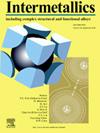Thermal deformation behavior and dynamic recrystallization mechanism of GH4065A alloy considering the effect of γ′ phase
IF 4.8
2区 材料科学
Q2 CHEMISTRY, PHYSICAL
引用次数: 0
Abstract
In this paper, the thermal deformation behavior of GH4065A alloy at high temperature was studied by thermal simulation compression test. The effects of deformation temperature and strain rate on microstructure evolution and dynamic recrystallization mechanism were studied by electron backscattered diffraction (EBSD) technology and transmission electron microscopy (TEM). It is proved that different deformation parameters lead to significant differences in flow behavior and dynamic recrystallization behavior. The results show that dynamic recrystallization (DRX) fraction and deformation temperature have the same variation trend. In the range of high strain rate, DRX fraction increases with the increase of strain rate. During the hot deformation process, the dynamic recrystallization mechanism of the GH4065A alloy is primarily characterized by discontinuous dynamic recrystallization (DDRX) through the nucleation form of grain boundary bulging. In the γ+γ′ two-phase region, twin-induced recrystallization (TDRX) nucleation and γ′ phase-induced recrystallization (PIDRX) nucleation phenomena are present. As the deformation temperature rises above the dissolution temperature of the γ′ phase, the effects of continuous dynamic recrystallization (CDRX) and TDRX in the deformed samples are diminished. The dissolution of the γ′ phase results in the loss of its pinning effect, while the coarsened γ′ phase significantly reduces its promoting effect on the DRX nucleation process, leading to a notable increase in grain size.
考虑γ′相影响的 GH4065A 合金的热变形行为和动态再结晶机理
本文通过热模拟压缩试验研究了 GH4065A 合金在高温下的热变形行为。通过电子反向散射衍射(EBSD)技术和透射电子显微镜(TEM)研究了变形温度和应变速率对微观结构演变和动态再结晶机制的影响。研究证明,不同的变形参数会导致流动行为和动态再结晶行为的显著差异。结果表明,动态再结晶(DRX)分数和变形温度具有相同的变化趋势。在高应变速率范围内,DRX 分数随应变速率的增加而增加。在热变形过程中,GH4065A 合金的动态再结晶机制主要表现为通过晶界隆起的成核形式产生的不连续动态再结晶(DDRX)。在γ+γ′两相区,存在孪晶诱导再结晶(TDRX)成核和γ′相诱导再结晶(PIDRX)成核现象。当变形温度升高到高于γ′相的溶解温度时,变形样品中的连续动态再结晶(CDRX)和TDRX效应减弱。γ′相的溶解导致其针刺效应丧失,而γ′相的粗化则显著降低了其对 DRX 成核过程的促进作用,从而导致晶粒尺寸明显增大。
本文章由计算机程序翻译,如有差异,请以英文原文为准。
求助全文
约1分钟内获得全文
求助全文
来源期刊

Intermetallics
工程技术-材料科学:综合
CiteScore
7.80
自引率
9.10%
发文量
291
审稿时长
37 days
期刊介绍:
This journal is a platform for publishing innovative research and overviews for advancing our understanding of the structure, property, and functionality of complex metallic alloys, including intermetallics, metallic glasses, and high entropy alloys.
The journal reports the science and engineering of metallic materials in the following aspects:
Theories and experiments which address the relationship between property and structure in all length scales.
Physical modeling and numerical simulations which provide a comprehensive understanding of experimental observations.
Stimulated methodologies to characterize the structure and chemistry of materials that correlate the properties.
Technological applications resulting from the understanding of property-structure relationship in materials.
Novel and cutting-edge results warranting rapid communication.
The journal also publishes special issues on selected topics and overviews by invitation only.
 求助内容:
求助内容: 应助结果提醒方式:
应助结果提醒方式:


